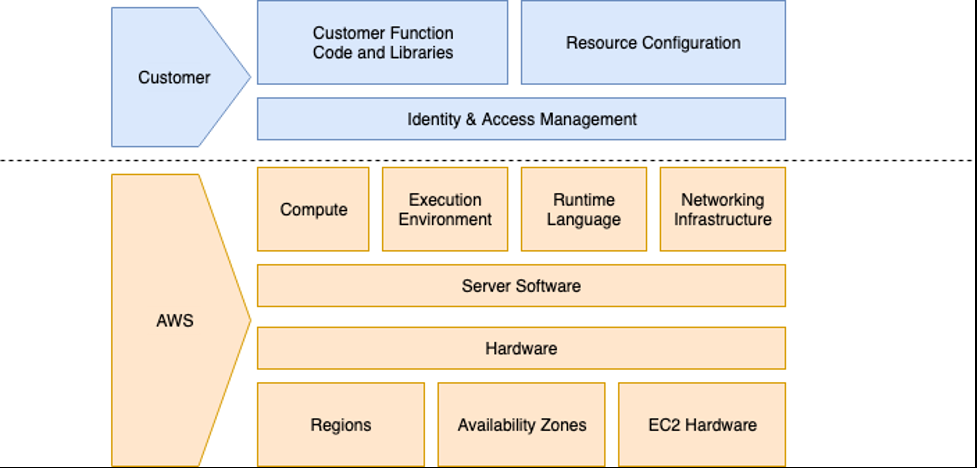This content originally appeared on Bits and Pieces - Medium and was authored by Lahiru Hewawasam
Unlocking the Full Potential of Microservices with Serverless Technology

Introduction
Serverless and microservices are a couple of very popular buzzwords that are thrown around during a technology-related discussion. These approaches have been independent of one another for some time, however, with the increased innovation and adoption of these technologies have aligned them so that they complement each other.
In this article, we will dive into the challenges of implementing distributed systems and how serverless technologies can bridge some of these challenges.
Microservices — the industry norm
In recent years, the industry standard for creating sophisticated software applications has been the microservices architecture. A large application is divided into smaller, independent services that can be developed, tested, and deployed separately using this method of software design. Greater flexibility and scalability in software development are two key advantages of microservices. Since each service can be updated or replaced without affecting the entire application, it becomes simpler to maintain and debug the application due to its modular design. Additionally, microservices architecture allows for each service to be deployed on a separate server or container, resulting in more effective resource management.”
Microservices also allow for an added advantage over traditional architectures since it allows developers the flexibility to use different programming languages and frameworks to create individual microservices. This method brings in more technological options into the development process.
Challenges with distributed systems that power microservices
With every technological benefit comes several challenges when implementing them at scale, and it is the same with microservices. Even though microservices offer superior scalability and flexibility during the development process, the nature of the microservices brings in some challenges.
We will look at some of the most prominent challenges that must be considered when implementing a distributed system with microservices.
Difficult to manage
Distributed systems are composed of multiple interconnected components that are spread out across different physical or virtual machines, making it hard to coordinate their activities and ensure they are working together as intended.
Reliability and consistency are some factors that play a predominant role in the success of a system. However, with microservices, any component within the service can fail at any time, and it may be difficult to diagnose the root cause of the failure. This means that distributed systems need to be designed with fault tolerance in mind so that they can continue to function even when one or more components fail. Additionally, techniques and technologies to troubleshoot and drill down into the root cause of these issues must also be thought about as a part of the design.
💡 By using an open-source toolchain like Bit, you can ensure reliability in a microservice architecture by making sure your components are made independent, then versioned, tested, and shared across different microservices, with automatic semver and a dependency graph for each. This reduces the risk of failures caused by inconsistent dependencies or code duplication.
Find out more here:
Component-Driven Microservices with NodeJS and Bit
Need for complex infrastructure
The infrastructure for distributed systems must be able to handle a high volume of data traffic between components. This requires designing a network that can handle large amounts of data and ensuring that each component has adequate bandwidth to communicate effectively.
Another challenge associated with complex infrastructure is the need for scalability. As the number of components and services within the system grows, the infrastructure must be able to scale up to accommodate the increased traffic and workload. To achieve this, it is important to design the infrastructure with scalability in mind, including the ability to add more components or machines to the system as needed.
Need for proper communication patterns
Making sure that communication is effective and scalable is another challenge. To accomplish a business objective in a distributed system, multiple services may need to communicate with one another. However, if communication is not optimized, it may result in bottlenecks and delays, which will ultimately affect the system’s performance. For more details check this article.
High demand for observability
The enormous amount of data that needs to be monitored and analyzed presents one of the main difficulties with observability in distributed systems. Due to the interdependence of so many services, it can be difficult to sort through the mountain of data to find problems and gauge system performance. To effectively manage and analyze the data, you’ll need specialized tools and methods.
What serverless brings in
What is serverless computing?
Serverless computing is a cloud computing model where the cloud provider manages the infrastructure and automatically allocates resources as needed to run and scale applications. This allows developers to focus on writing code without worrying about the underlying infrastructure. The cloud provider runs the application code on its own servers, which are typically billed on a pay-per-use basis.
Serverless Management Responsibilities
One of the main advantages of using serverless technologies is that the developers are able to focus on the actual application development without having to worry about managing the underlying infrastructure. This is because the responsibility for managing the infrastructure is shifted from the developer to the serverless vendor.
For example, if you are using AWS Lambda as your serverless vendor, they will be responsible for managing the underlying infrastructure that runs your code. This includes managing the servers, scaling the resources up and down, monitoring the system for errors, and performing regular updates and maintenance.
In addition to managing the infrastructure, serverless vendors also take care of security and compliance. They provide a secure platform for developers to build and deploy their applications, and they ensure that the data and applications are protected from external threats.
However, this does not take away the responsibility of the developer to configure the appropriate configurations and to implement proper identity and access management capabilities to govern the access that Lambda may have. This is clearly depicted within the AWS Lambda shared responsibility model.

Figure 01: AWS Lambda Shared Responsibility Model
Ability to utilize services in your design
In today’s fast-paced world, agility is a crucial factor for success in any industry, and design is no exception. The ability to quickly adapt and incorporate new services and technologies into design processes can provide a significant competitive advantage. One way to achieve this agility in design is by utilizing services that are readily available for use.
With the adoption of serverless services, developers are now able to use and integrate existing services provided by cloud service providers without having to build the service from scratch. For example, incorporating a queue into an application has not always been easy due to the various scalability issues that it presented, however with serverless developers are able to integrate existing queue services that are provided by the cloud service provider such as the AWS Simple Queue Service (SQS) to easily integrate a functional and scalable queue into an existing application.
Serverless in action
Implementing and deploying a new API has never been easier with the use of serverless services. AWS being one of the leading cloud service providers and one of the pioneers of serverless technologies empowers developers with a vast array of powerful serverless services to fast-track application and API development.
AWS Lambda and Amazon API Gateway are two powerful serverless services offered by AWS for building serverless applications. Using these services together, developers can quickly create and deploy simple service APIs that can scale automatically and respond to user requests in real-time. With the application and API logic running on AWS Lambda, developers are able to segregate and split the logic into different logical microservices thus enabling the seamless adoption of serverless into microservices.
For this example, users are able to create AWS Lambda functions that hold the application logic to perform specific actions; this could also be integrated with other serverless services such as SQS or DynamoDB to add more functionality.
After creating the AWS Lambda function with the respective code, the users will be able to create an API gateway that will act as a front-end for the Lambda function. Amazon API gateway is capable of handling complex requests and methods, but users may configure the API Gateway to accept a simple GET request and trigger the Lambda function based on this request.
Once configured, the request will be accepted by the API gateway and will trigger the lambda function to perform the specific function.

Conclusion
Serverless computing has significantly reduced the challenges associated with managing distributed systems that power microservices. It enables more scalable, cost-effective, and efficient applications, increasing development speed. Utilizing services in design reduces infrastructure management, enabling developers to focus on building applications. Serverless computing has proven to allow seamless application scaling, making it a game-changer in practice. Understanding its impact on microservices is essential for remaining competitive in the evolving tech landscape.
From monolithic to composable software with Bit

Bit’s open-source tool help 250,000+ devs to build apps with components.
Turn any UI, feature, or page into a reusable component — and share it across your applications. It’s easier to collaborate and build faster.
Split apps into components to make app development easier, and enjoy the best experience for the workflows you want:
→ Micro-Frontends
→ Design System
→ Code-Sharing and reuse
→ Monorepo
Learn more
- From Monolith to Microservices Using Tactical Forking
- How We Build Micro Frontends
- How we Build a Component Design System
- How to reuse React components across your projects
- 5 Ways to Build a React Monorepo
- How to Create a Composable React App with Bit
The Impact of Serverless on Microservices: What You Need to Know was originally published in Bits and Pieces on Medium, where people are continuing the conversation by highlighting and responding to this story.
This content originally appeared on Bits and Pieces - Medium and was authored by Lahiru Hewawasam
Lahiru Hewawasam | Sciencx (2023-04-19T06:02:52+00:00) The Impact of Serverless on Microservices: What You Need to Know. Retrieved from https://www.scien.cx/2023/04/19/the-impact-of-serverless-on-microservices-what-you-need-to-know/
Please log in to upload a file.
There are no updates yet.
Click the Upload button above to add an update.
